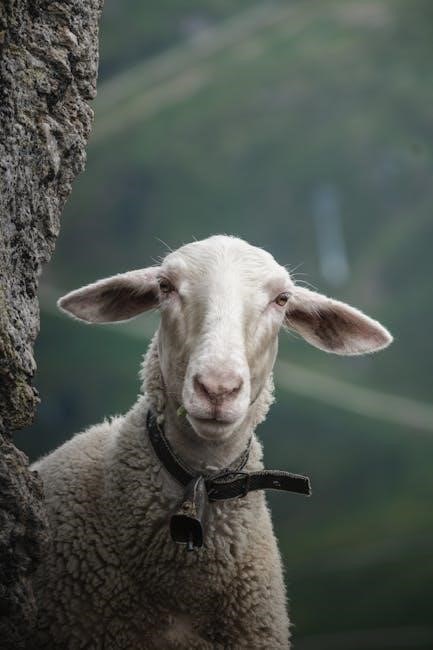William Eggleston’s Pioneering Role in Color Photography
Eggleston’s groundbreaking 1976 exhibition and accompanying book‚ ‘William Eggleston’s Guide’‚ at the Museum of Modern Art‚ was revolutionary. It boldly presented color photography as a legitimate art form. This challenged the established dominance of black and white in fine art and sparked debate. The guide showcased his unique vision.
Early Life and Influences
William Eggleston‚ born in 1939 in Memphis‚ Tennessee‚ spent his formative years in the Mississippi Delta‚ a region that would profoundly shape his artistic vision. Growing up in the American South‚ he was surrounded by the everyday scenes and objects that would later become the subjects of his iconic photographs. His early exposure to the vernacular aesthetic of the region‚ with its vibrant colors and distinctive character‚ is evident in his later work. Eggleston’s initial foray into photography began with black-and-white 35mm film‚ but his artistic sensibilities soon led him to explore the potential of color. His fascination with the world around him‚ coupled with his rebellious spirit‚ drove him to experiment with color photography at a time when it was largely dismissed by the fine art establishment. He was drawn to the naturalistic way that color captured the world‚ and his early experiences laid the foundation for his innovative approach to color photography.

Transition to Color Photography
Eggleston’s move to color photography in the mid-1960s marked a pivotal moment in the history of the medium. Initially working in black and white‚ he was introduced to color by William Christenberry and was immediately captivated by its potential. Eggleston saw color as a more accurate representation of the world‚ aligning with his desire to capture reality without artistic pretension. This transition was not without its challenges‚ as color photography was often relegated to commercial or amateur work‚ largely excluded from fine art circles. However‚ Eggleston was undeterred‚ driven by his belief in the artistic merit of color. His experimental approach led him to discover dye-transfer printing‚ a commercial technique that provided the rich saturation and vibrant colors he sought‚ allowing him to realize the full impact of his vision. This discovery solidified his commitment to color and propelled his pioneering journey.
The Revolutionary ‘William Eggleston’s Guide’
‘William Eggleston’s Guide’‚ both the 1976 exhibition at MoMA and the accompanying book‚ was a watershed moment for color photography. It presented a collection of seemingly mundane images‚ elevated by Eggleston’s keen eye for composition and his mastery of color. The exhibition‚ curated by John Szarkowski‚ was the first solo show of color photography at the prestigious museum‚ a move that challenged the established norms of the art world. The images featured everyday scenes⁚ gas stations‚ parking lots‚ and ordinary objects‚ rendered with a level of artistic integrity that was previously unseen in color photography. The ‘Guide’ wasn’t just a display of technically proficient color prints; it was a declaration of color’s artistic potential. It sparked controversy‚ with some critics dismissing it as banal‚ while others hailed it as a revolutionary turning point‚ marking the beginning of color’s acceptance into the realm of fine art. The book itself became a seminal text‚ influencing generations of photographers.
Eggleston’s Unique Style and Techniques
William Eggleston’s style is characterized by its seemingly casual approach‚ yet it reveals a deeply considered vision. He employed a “democratic” approach to photography‚ capturing everyday subjects with equal attention‚ regardless of their perceived significance. His use of the dye-transfer printing process was crucial to his aesthetic‚ allowing for rich‚ saturated colors that enhanced the emotional impact of his images. Eggleston favored the Leica camera‚ often paired with a custom-mounted f0.95 Canon lens‚ to capture his subjects with remarkable clarity and detail. He worked primarily with analog film‚ rejecting digital photography entirely. His technique was rooted in observation‚ responding to the world around him with an intuitive understanding of light‚ color‚ and composition. Eggleston often used unconventional framing and angles‚ creating visually dynamic compositions that defied traditional photographic conventions. His method involved a balance of spontaneity and precision‚ resulting in photographs that were both evocative and technically masterful. This combination of a unique perspective and technical expertise is what defines his distinctive style.

Use of Color and Composition
Eggleston’s use of color is not merely decorative; it’s a fundamental element of his storytelling. He didn’t shy away from bold‚ saturated hues‚ embracing the full spectrum with an almost painterly approach. The dye-transfer process‚ which he championed‚ allowed him to achieve an unparalleled richness and depth in his colors‚ enhancing the emotional resonance of his images. His compositions often seem spontaneous‚ yet they are meticulously crafted‚ balancing elements within the frame to create a sense of order and visual harmony. He used color to draw attention to specific details‚ guiding the viewer’s eye through the photograph and revealing hidden narratives. Eggleston’s approach to composition often involved unconventional angles and perspectives‚ adding a sense of dynamism and surprise. He was known to utilize strong leading lines‚ geometric shapes‚ and negative space in order to create balanced and visually compelling images. His use of color and composition worked together in order to establish a unique and captivating visual language.
Focus on Everyday Subjects
Eggleston’s photography is characterized by its focus on the mundane and the everyday. He found beauty and significance in ordinary objects‚ scenes‚ and people‚ often overlooked by others. From roadside diners and gas stations to parked cars and cluttered interiors‚ Eggleston’s subjects are the unassuming elements of American life. He approached these subjects with a democratic eye‚ without imposing any preconceived notions of beauty or importance. He captured them as they were‚ in their raw and unadulterated form. His work elevates the ordinary to the extraordinary‚ revealing the inherent poetry and complexity of the world around us. This focus on the mundane was a radical departure from the traditional subjects of fine art photography‚ which often favored the dramatic‚ the exotic‚ or the overtly beautiful. Eggleston’s work showed that even the most ordinary of subjects had the potential to be art when viewed through the lens of a gifted artist. He had an ability to find the captivating in the common‚ urging the viewer to look more closely at the details and moments that often go unnoticed.

Unconventional Framing and Angles
William Eggleston’s approach to composition is marked by his use of unconventional framing and angles‚ adding a distinct visual dynamic to his work. He often employed unusual perspectives‚ shooting from low angles‚ high vantage points‚ or off-center positions that disrupt the viewer’s expectations. This departure from traditional framing techniques creates a sense of unease and disorientation‚ forcing the viewer to reconsider the subject in a new light. Instead of striving for perfect balance or symmetry‚ Eggleston embraces asymmetry and the unexpected. His compositions are often fragmented‚ with objects or figures cropped in unexpected ways‚ drawing the viewer’s eye to particular details and creating a sense of visual tension. These choices contribute to the seemingly spontaneous nature of his work‚ as if he had simply stumbled upon these scenes and captured them exactly as he found them. His use of unusual angles and framing is not arbitrary; it serves to enhance the emotional impact of his images and invite viewers to engage with the world in a more nuanced and thoughtful way. This contributed to his unique and recognizable style.
Impact on Fine Art Photography

William Eggleston’s impact on fine art photography is profound and far-reaching‚ primarily through his pivotal role in legitimizing color photography as a serious artistic medium. Before Eggleston‚ color was often relegated to commercial or amateur work‚ while black and white dominated the fine art scene. His bold decision to embrace color‚ and his subsequent success‚ opened the doors for countless other photographers to explore the artistic potential of color. Moreover‚ Eggleston’s “democratic” approach to subject matter‚ focusing on everyday scenes and objects‚ challenged the notion that only certain subjects were worthy of artistic attention. He demonstrated that beauty and meaning could be found in the mundane‚ and that these everyday moments could be just as compelling and evocative as traditionally “artistic” subjects. This shift in perspective broadened the scope of what was considered acceptable in fine art photography‚ inspiring a new generation of photographers to look at their surroundings with fresh eyes. Eggleston’s influence continues to shape contemporary photography‚ and his work remains a testament to the power of a unique artistic vision.
Eggleston’s Legacy and Continued Influence
William Eggleston’s legacy is firmly cemented as a transformative figure in the history of photography. His pioneering efforts in establishing color photography as a legitimate art form have had a lasting impact‚ paving the way for countless photographers who followed. His influence extends beyond the mere use of color; it’s also evident in his approach to subject matter‚ his focus on the everyday‚ and his unique perspective on the world. Eggleston’s work continues to inspire photographers to find beauty and meaning in the mundane and to explore the artistic possibilities of their immediate surroundings. He demonstrated that seemingly ordinary scenes‚ when viewed through a discerning eye‚ could be both visually striking and profoundly evocative. His democratic approach‚ capturing the world without assigning inherent value to specific subjects‚ has encouraged photographers to embrace a more inclusive and less judgmental perspective. Moreover‚ his meticulous attention to composition and his innovative use of color have served as a guide for generations of artists. Eggleston’s impact is not just historical; his work continues to resonate with contemporary photographers and artists.
Notable Works and Publications
William Eggleston’s contributions to photography are not only marked by his groundbreaking techniques but also by his significant publications. Among his most notable works is ‘William Eggleston’s Guide‚’ the catalog accompanying his groundbreaking 1976 MoMA exhibition. This publication served as a pivotal moment in the acceptance of color photography as fine art‚ showcasing his unique vision and style. Another essential publication is ‘The Democratic Forest‚’ a multi-volume collection presenting a vast archive of Eggleston’s work‚ further solidifying his approach to photographing the world around him. These publications‚ alongside other noteworthy works‚ such as ‘Chromes’‚ which demonstrates his artistic growth‚ and ‘The Outlands‚’ which reveals unseen works from his early years‚ offer a comprehensive view of his diverse and influential career. His use of dye-transfer printing‚ which he brought from commercial industries into the art world‚ is also notable. These publications demonstrate not only his technical expertise but also his distinctive way of viewing the world. They remain essential resources for understanding Eggleston’s impact on the field of photography.




Leave a Reply
You must be logged in to post a comment.